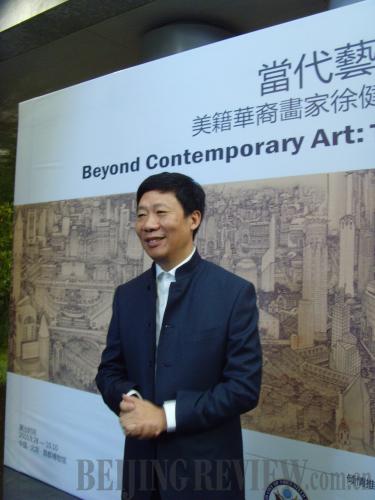|
 |
|
Xu Jianguo (XIAO YAN) |
A solo exhibition of paintings by Chinese-American artist Xu Jianguo was held from September 28 to October 10 at Beijing's Capital Museum. The exhibition, Beyond Contemporary Art: The Artistic Vision of Xu Jianguo, marked the first time the U.S. Embassy in China teamed up with the Capital Museum.
Providing a comprehensive overview of Xu's artistic creativity, the exhibition presented a selection of the artist's most important works created in more than 40 years—before and after the artist's emigration to the United States, including the newly completed Shanghai: A New Vista and more than 20 other works.
The exhibition is divided into three sections: abstract paintings, Western paintings and the two versions of Shanghai: A New Vista.
Among the abstract works, some, such as Change, Happiness and Root, were created before the artist left China in 1984 that show the artist was able and willing to go beyond the rules of traditional Chinese ink painting.
Another abstract painting, The Ocean, was painted during his studies at Bard College in New York City. The work was inspired by a journey in the artist's youth, when he once experienced the darkness and terror of sailing through a typhoon. The artist's portrayal of heavy rains and waves melding into the ominous sky vividly conveys the raw power of nature and the insignificance of man.
Xu's Western paintings are actually a fusion of East and West, in both the medium and methods used. The unique medium, which was developed by the artist, is rice paper bonded on canvas with applications of water-ink techniques and acrylics. This allows for the translucent and powerful shapes and colors to coexist. The visual effect is complex and speaks to the artist's borderless artistic vision.
The biggest highlight of the exhibition was undoubtedly the two versions of a long scroll painting Shanghai: A New Vista, which drew the most visitor interest.
At first glance, the grand work may remind visitors of the famous ancient Chinese painting Riverside Scene at Qingming Festival, a 24.8 cm-wide and 5.2 m-long painting created by Zhang Zeduan of the Northern Song Dynasty (960-1127).
In Xu's painting, it seems that the classical is reborn as contemporary. Shanghai: A New Vista, which has a 6.06 m by 47.9 cm ink version and a 8.06 m by 47.5 cm color-ink version, depicts Shanghai's urban construction and development. It shows more than 7,000 buildings in Shanghai and highlights the skyscrapers of the city's financial district Lujiazui, the rapidly changing city center of People's Square, the green and peaceful area of Western style architecture built in the 1930s and 1940s and the spectacular Chinese gardens in the suburb. Through variations in color and brightness, the artist portrays a 24-hour Shanghai cityscape.
"Instead of traditional landscape subjects, such as mountains and rivers, I chose a contemporary city scene in the painting, hoping to transcend the traditional form and capture the spirit of Chinese culture," said Xu.
As for managing the numerous objects in such a grand work, he said when he drew part of the scene, he regarded every object, buildings or trees, as different members in a family, such as a mother, a son or a daughter. "Every member has its own characteristics. All the objects constitute the whole picture, like family members forming a family," he said.
The grand work took Xu 14 years from conception to completion. "I think everyone should do something he believes to be valuable in his lifetime. That's why, starting in 1994, I began to give up almost all the work to concentrate on this," he said.
"Fourteen years is a long time. And it is hard. However, when you have experienced much harder times in your youth, you will be afraid of nothing else."
"I was impressed by this work. The artist has employed the traditional Chinese ink painting technique to express the contemporary urban scene. He successfully melds Eastern abstract brushwork and Western color sensibility to create works that push the boundaries of contemporary art. This is a testament to his cross-cultural heritage and the depth of his mastery of both techniques," said Zhu Mingyang, a former researcher at the Metropolitan Museum of Art in New York City and now Deputy Curator of the World Art Museum in Beijing.
Born in Shanghai in 1951, Xu studied traditional brush painting in his early childhood and was trained by Chinese painting master Ye Zhihao. Before he entered college, the "cultural revolution" (1966-76) began in China, and he was asked to work on a farm on Chongming Island in Shanghai. Despite hardships, he never stopped drawing. In 1973, Xu began to study at the Shanghai Theater Academy. In 1984, Xu received a scholarship and fellowship from the Bard College in the United States, where he received his MFA in 1987.
Xu has had numerous solo painting exhibitions worldwide. His works have also been featured in both Christie's and Sotheby's Important Contemporary Chinese Art Sales.
When the two versions of Shanghai: A New Vista were completed last year, they drew wide attention from art critics, collectors and auction houses. A British collector wanted to add the scrolls to his collection and display them at the British Museum, but Xu rejected the offer. "I felt the painting is for his two homes, China and the United States," Xu said. Before the exhibition in Beijing, the work was displayed in the VIP lounge of the Theme Pavilion at the 2010 World Expo in Shanghai.
The exhibition at the Capital Museum has strengthened the understanding between the museum and some U.S. art institutions, said Guo Xiaoling, Curator of the museum.
In recent years, the museum has intensified the cooperation with its foreign counterparts and relevant organizations in order to improve international exchanges. Just before this project, the museum successfully held the Arabic Art Exhibition, with the cooperation of the Arab League.
| 